Military powers around the world are taking conflict technology to the next frontier – outer space.
In the never-ending quest to find weapons that will give a country the power it needs to knock out its adversaries, a new type of weapon has emerged: ultra-fast “hypersonic” missiles that can change targets anywhere on Earth within an hour.
Our modern life and its increasing reliance on an ever-expanding network and array of satellites mean that, once again, space has emerged as a new arena for warfare.
What are hypersonic weapons?
The word “hypersonic” means anything that moves at five times the speed of sound – 6,174 kilometres per hour or more – in other words, ultra-fast. Speed is important as it gives an opponent less warning and less time to react.
Most ballistic missiles already move this fast; what makes hypersonic missiles different is that they glide in the upper atmosphere and are highly manoeuvrable. Ballistic missiles, once launched, have very limited possibilities to alter their course, much like a ball once thrown.
These new missiles come in two forms; the first are hypersonic glide vehicles (HGVs), which leave the Earth’s atmosphere and then plunge back into it, gliding through the upper layers in a shallow, random series of curves and turners, intended to fool an enemy’s radar as to their intended target.
The other type is the hypersonic cruise missile (HCM) which, while not as fast, is designed to fly low but also at extremely high speeds, surprising the enemy and giving it very little time to react.
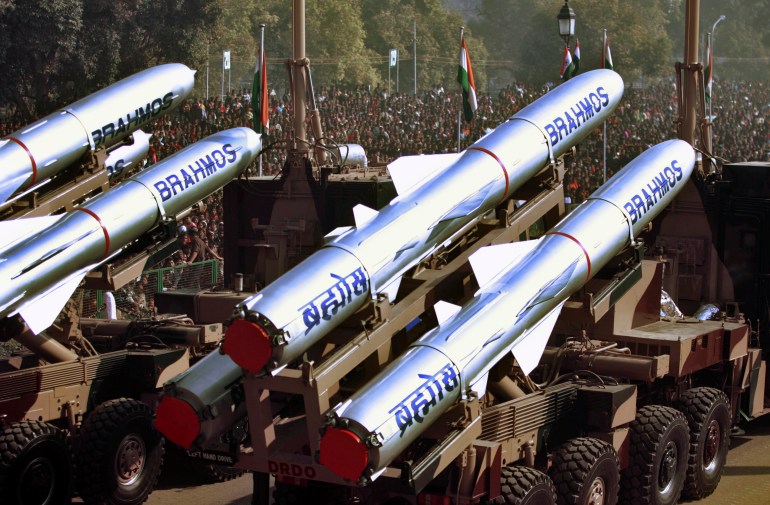 In a photo from January 26, 2007, the Indian Army’s Brahmos missiles, a supersonic cruise missile, are displayed during the Republic Day Parade in New Delhi [File: Gurinder Osan/AP Photo]
In a photo from January 26, 2007, the Indian Army’s Brahmos missiles, a supersonic cruise missile, are displayed during the Republic Day Parade in New Delhi [File: Gurinder Osan/AP Photo]Communication is a problem for these high-value weapons as the intense heat builds up a cloud of super-charged particles around them called plasma, which is very hard for normal radio communications to penetrate. A similar problem exists for spacecraft on atmospheric re-entry and, in those moments, communications are usually blacked out.
Manoeuvrability at such high speeds, a key attribute of these weapons, places serious strain on the structure of the missile and early test models have literally torn themselves apart while attempting to steer a new path. All these challenges mean these new weapons have still not been fully developed as designers struggle to produce viable test models that can be made operational.
China, Russia and the US – a new arms race
While the United States and Russia have traditionally been at the forefront of these sorts of new technologies, other countries are catching up fast and even threaten to overtake them.
 In a photo from October 1, 2019, military vehicles carrying hypersonic missiles drive past Tiananmen Square during a military parade marking the 70th anniversary of the founding of the People’s Republic of China [File: Thomas Peter/Reuters]
In a photo from October 1, 2019, military vehicles carrying hypersonic missiles drive past Tiananmen Square during a military parade marking the 70th anniversary of the founding of the People’s Republic of China [File: Thomas Peter/Reuters]Russia is crash-testing its own missile, called Avangard, which uses a similar configuration to the Chinese one. Launched on top of a ballistic missile, it detaches itself from the missile once in space and re-enters the atmosphere, gliding to its target at incredible speeds of up to 33,000 km/h. The first missile regiment armed with this new weapon went operational in December 2019, making Russia the first country in the world to openly incorporate a working HGV into its arsenal.
Several other countries are researching the technologies. India is developing a hypersonic variant of its BrahMos missile and France and Japan will have a working hypersonic cruise missile in their arsenals by 2022 and 2026, respectively.
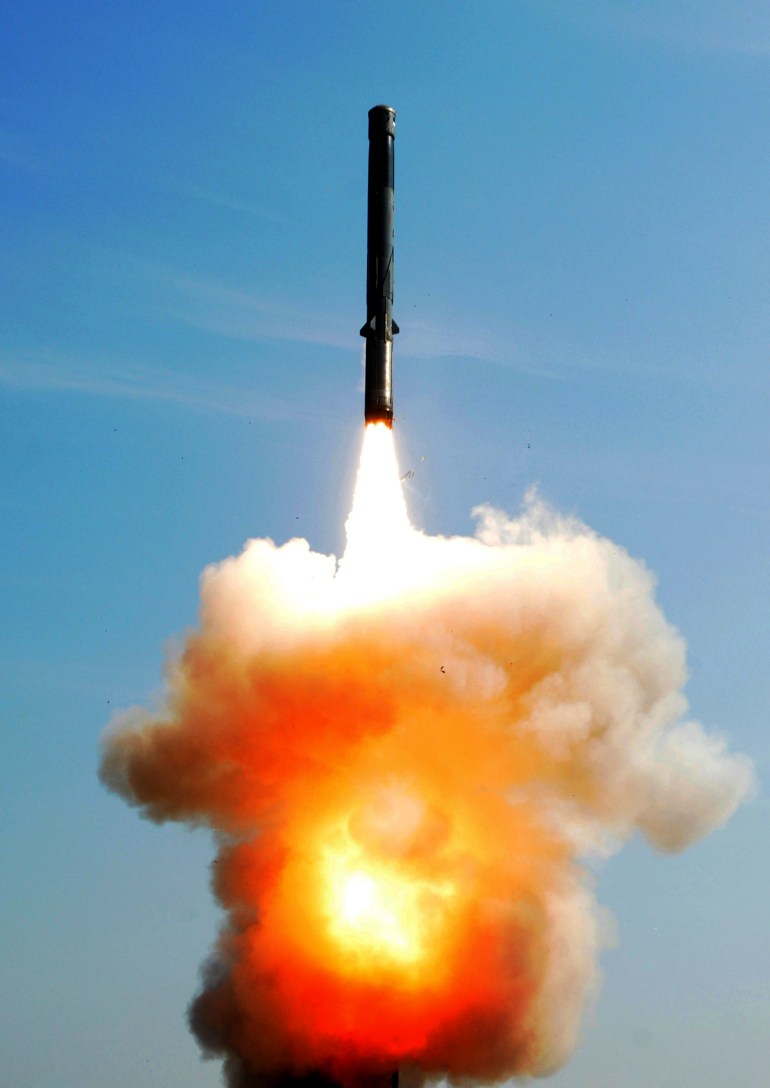 In a photo taken on December 2, 2010, the BrahMos missile takes off from India’s main missile testing centre in the eastern state of Orissa [File: AP Photo]
In a photo taken on December 2, 2010, the BrahMos missile takes off from India’s main missile testing centre in the eastern state of Orissa [File: AP Photo]There are serious concerns about whether these missiles will carry conventional or nuclear warheads. An adversary detecting a missile coming towards it would not know what payload it was carrying and assume the worst, thinking it was under nuclear attack. There would be very little time left for decision making, the temptation being to launch a nuclear counterattack before its own forces were potentially destroyed.
Outer space – the new ‘warfighting domain’
While this new class of weapon is being developed at breakneck pace, a new frontier is also opening up in the quest for military supremacy – outer space.
Ever since the launch by the Soviet Union of the first man-made satellite, Sputnik, in 1957, space has been looked on by the world, concerned this new domain could quickly become militarised. Over the decades, technological limits, coupled with harsh economic realities, have meant that for the past few decades, space weapons have been researched, developed then ditched.
 In this photo taken from a video distributed by the Russian Defense Ministry Press Service on October 7, 2020, a Russian Zircon hypersonic cruise missile is launched from the Admiral Groshkov frigate, in the White Sea, north of Russia [Russian Defense Ministry Press Service via AP]
In this photo taken from a video distributed by the Russian Defense Ministry Press Service on October 7, 2020, a Russian Zircon hypersonic cruise missile is launched from the Admiral Groshkov frigate, in the White Sea, north of Russia [Russian Defense Ministry Press Service via AP]Both civilian and military life increasingly depends on our vast array of satellites for communications, location and data transmission. Major powers have been researching ways to sabotage or knock out these satellites and the development of anti-satellite – or ASAT – weapons is a growth area, although only four countries – the United States, Russia, India and China – have so far managed to test them.
China has a large arsenal of ASAT weapons, poised to blind an adversary in any potential conflict. This includes work on a ground-based laser weapon designed to destroy satellites in low Earth orbits.
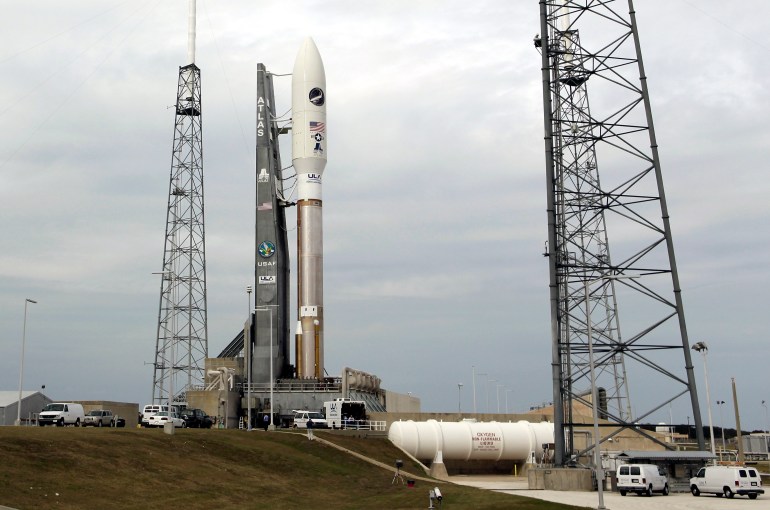 In a photo from December 10, 2012, a United Launch Alliance Atlas V rocket stands ready for launch on the Complex 41 pad at the Cape Canaveral Air Force Station in Florida in the United States [File: John Raoux/AP Photo]
In a photo from December 10, 2012, a United Launch Alliance Atlas V rocket stands ready for launch on the Complex 41 pad at the Cape Canaveral Air Force Station in Florida in the United States [File: John Raoux/AP Photo]Seeing the potential for sabotage, research is now focused on bodyguard satellites that will protect vital arrays from interference. Space-based lasers are being considered for both attack and defence. With a laser, there is no recoil to knock a bodyguard satellite off-course; they also perform much better in a vacuum.
The US Defense Advanced Research Projects Agency (DARPA) is designing a reusable spacecraft based on the X-37B that can take off and perform 10 missions in as many days. This will dramatically help the United States assemble arrays of space-based weapons as well as significantly lower the time and costs of space travel.
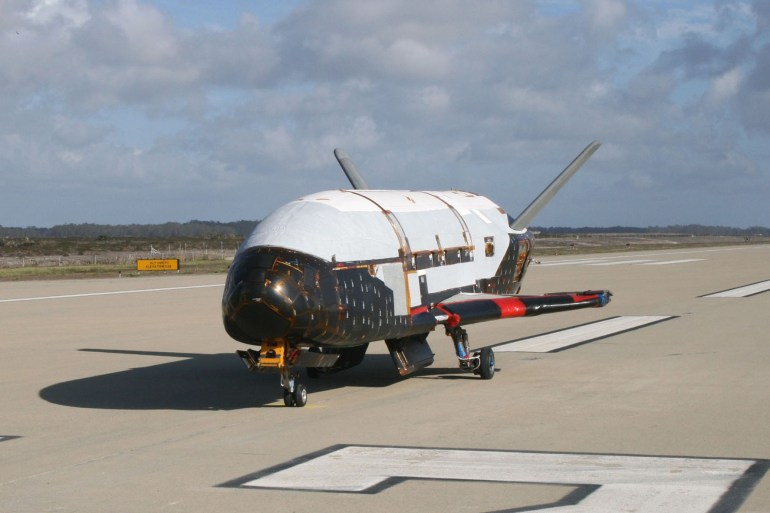 This June 2009 photo made available by the US Air Force via NASA shows the X-37B Orbital Test Vehicle at Vandenberg Air Force Base, California [File: US Air Force via AP]
This June 2009 photo made available by the US Air Force via NASA shows the X-37B Orbital Test Vehicle at Vandenberg Air Force Base, California [File: US Air Force via AP]Space Force
Much ridiculed at its inception in 2019, this new independent branch of the US military will pool resources from all the other branches, communications, unmanned spacecraft and personnel, to focus their capabilities on this new warfighting domain. Space Force will maintain ties with all the other service branches of the US military as well as assist in helping NATO’s new Space Operations Center in Ramstein, Germany.
Space Force is not the stuff of science fiction, with manned spacecraft taking off and doing battle in orbit, but it is an acknowledgment by the United States that this new realm needs renewed focus on resources and command if there is ever to be a conflict fought in it. DARPA is already designing its own version of an “inspector satellite” dubbed the “robotic serving vehicle” (RSV). This will fix old and defective satellites, but, like those owned by Russia, there is no reason at all they cannot be weaponised to attack those of other countries.
With new fast and reusable spacecraft in the pipeline, unmanned craft already being regularly launched, offensive and defensive satellite operations being planned and threats from several powers to be dealt with, Space Force has already morphed from a largely theoretical organisation to an integral part of the US military with rapidly growing capabilities.
 In this photo from January 31, 2019, Cadet 2nd Class Eric Hembling uses a Ludwieg Tube to measure the pressures, temperatures, and flow field of various basic geometric and hypersonic research vehicles at Mach 6 in The United States Air Force Academy’s Department of Aeronautics, in Colorado Springs, Colorado [File: Joshua Armstrong/US Air Force Academy via AP]
In this photo from January 31, 2019, Cadet 2nd Class Eric Hembling uses a Ludwieg Tube to measure the pressures, temperatures, and flow field of various basic geometric and hypersonic research vehicles at Mach 6 in The United States Air Force Academy’s Department of Aeronautics, in Colorado Springs, Colorado [File: Joshua Armstrong/US Air Force Academy via AP]The end of a new beginning?
An arms race is firmly in place as powers vie for supremacy in the new fields of weaponry and warfare. The last of the great Cold War arms treaties, New Strategic Arms Reduction Treaty (START) teeters in the balance.
Signed in 2010 between the United States and Russia, this treaty will be rendered defunct in a few months as it was never designed to control or limit this new class of weaponry. Russia has requested an extension to START and has said it would consider Avangard as being bound by the treaty’s limitations.
The treaty also does not include China, whose arsenal of both conventional and nuclear weapons grows unchecked by the day. China has shown little interest in limiting its growing military prowess and is crashing the development programmes of these new weapons in an effort to catch up, achieve parity and eventually overtake its rivals in terms of combat power.
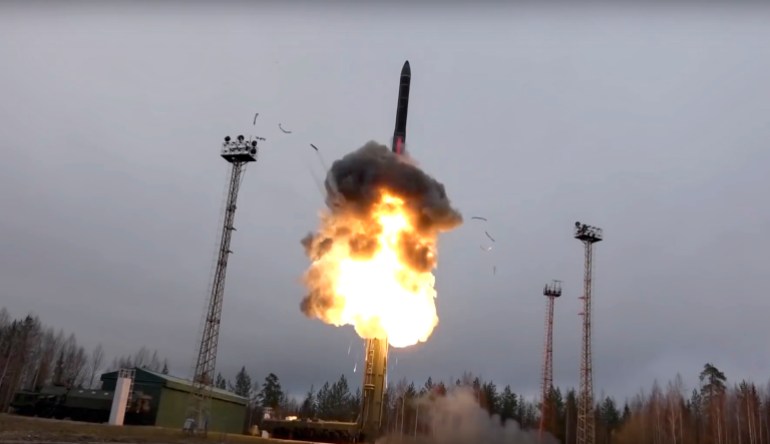 In a photo taken from undated footage distributed by the Russian Defense Ministry Press Service, an intercontinental ballistic missile lifts off from a truck-mounted launcher somewhere in Russia [File: Russian Defense Ministry Press Service via AP]
In a photo taken from undated footage distributed by the Russian Defense Ministry Press Service, an intercontinental ballistic missile lifts off from a truck-mounted launcher somewhere in Russia [File: Russian Defense Ministry Press Service via AP]The United States has deemed it necessary to form a new branch of the military, integrating these concepts. NATO has declared space a new warfighting domain. Russia and China are also researching new weapons in order to leverage their militaries.
An intense race is on between the world’s powers for control of these new technologies and for mastery of orbital space. This is spurred on by the tantalising prospect that possession of these new weapons will give a country the boost it needs to prevail over the United States, currently the pre-eminent military power on earth. The United States, for its part, wishes to keep its number one slot.
As with all arms races, the aim is either to achieve a dominant position or play catch-up to those that do.

No comments:
Post a Comment